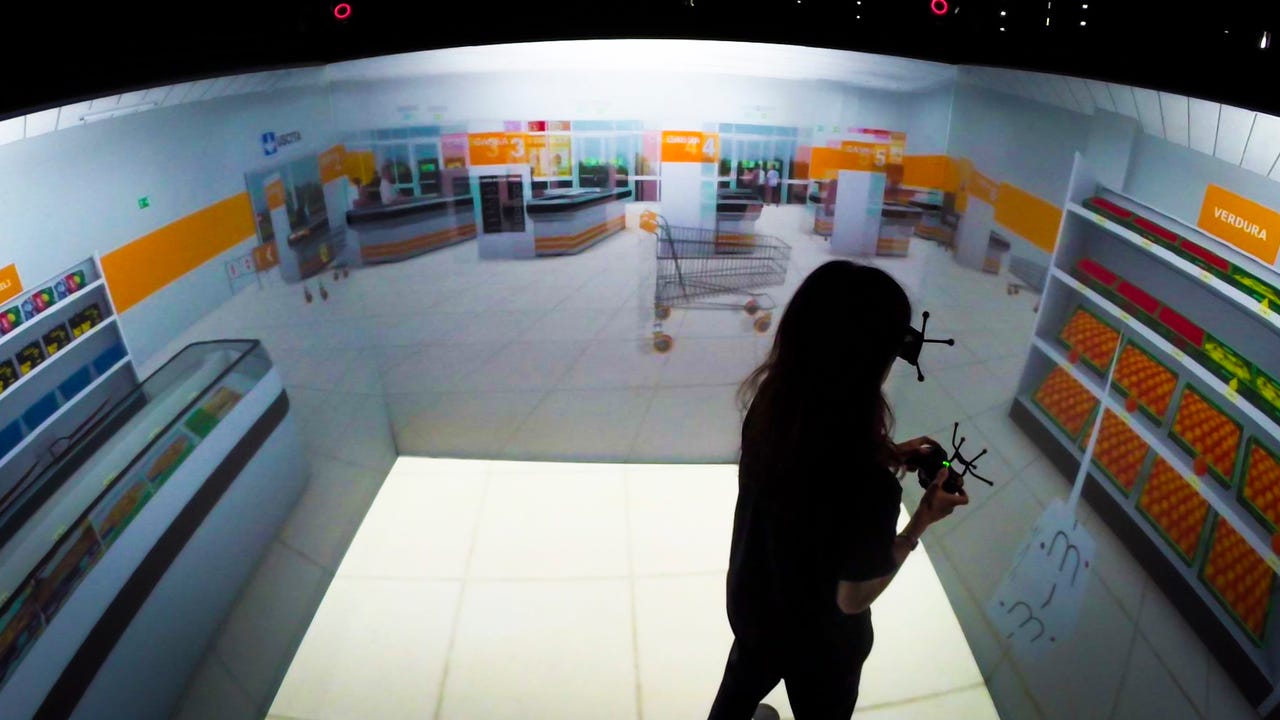How doctors are prescribing VR to help patients cope with real life

Treating a patient with virtual reality allows for more personalized rehabilitation sessions.
The woman enters the supermarket. She grabs a cart and then walks round the aisles to find the goods she needs. Having carefully picked various products, paying close attention to prices, she eventually heads to the checkout.
A scene like that happens every day in countless stores all over the world. But this time, it's a bit different. The woman is actually moving around in a small cubicle called CAVE, which measures 3m by 3m, and 2m high, as she holds a game controller in her hands and wears a pair of 3D glasses.
The supermarket is virtually recreated on three translucent acrylic panels by four 1,600 x 1,200-pixel projectors placed over the cubicle -- one for each of the three walls and one for the floor -- connected to two high-end workstations.
What makes the scene even less common is that it takes place at the Istituto Auxologico Italiano of Milan, Italy -- a hospital. The clinic is breaking new ground in the field of rehabilitation by allowing people dealing with the symptoms of various neurological diseases to follow a pioneering program that includes immersive virtual reality.
"There are other CAVEs in various medical institutions in Europe but they are used for research purposes only," Marco Stramba-Badiale, director of the Department of Geriatrics and Cardiovascular Medicine and the Laboratory of Experimental Rehabilitation Research, tells ZDNet.
"We're the first to offer such technologies to ordinary patients. We think the CAVE is a powerful tool in rehabilitation after a stroke, or in the initial stages of Alzheimer's or in Parkinson's therapy."
The CAVE, together with its sister system located on a different floor of the institute, was inaugurated last July and are the outcome of a €1m ($1.1m) investment co-funded by the Italian Ministry of Health.
According to the doctors, virtual reality, and particularly immersive environments such as these, have some advantages over traditional approaches because they put patients in real-life settings such as supermarkets, restaurants, or public parks.
"They can interact with the same places they are likely to find outside the hospital, and that makes the rehabilitation effect more likely to translate into their day-to-day life," Stramba-Badiale explains.
A patient in a CAVE, for instance, can be instructed to walk up to a newsstand located in a virtual public square and then be asked to repeat the operation from a different starting point.
"That's a fairly trivial task for normal people but it can be difficult for a person suffering from Alzheimer's," he adds.
As the patients move their feet in CAVE, explore the shelves with the joystick or turn their eyes in various directions, they feel immersed in the selected environment.
Their perspective changes according to their point of sight and the position of the virtual objects with which they're interacting, thanks to six reflective markers on the glasses that communicate with four motion-tracking infrared video cameras located on the frame supporting the walls.
Treating a patient with virtual reality also allows for more personalized rehabilitation sessions, because it is possible to accurately calibrate the work and the settings to meet the needs and reactions of the individual.
"For instance, if you put a person in an apartment-like environment, you can see which areas of the home and which objects that individual has more difficulties to deal with and then make the patient work more in those areas," Stramba-Badiale says.
That's the reason why many rehabilitation centers have physically recreated real-life environments, such as kitchens or bathrooms, in their locations.
However, virtual reality allows for an almost endless choice of settings and greater flexibility at a lower cost. Currently the Istituto Auxologico's CAVEs, which were implemented by the Milan-based gaming company Forge Reply, allow doctors and physiotherapists to choose between more than 15 virtual scenarios.
These scenarios include one that puts a person in front of a virtual seated audience to help the patient overcome a fear of speaking in public.
These settings can be easily modified and new ones can be added without much effort because the CAVEs were assembled using off-the-shelf hardware and software.
At the core of the architecture lies some popular middleware provided by French company MiddleVR, which is almost a de facto standard for VR systems, while the ubiquitous Unity3D serves as the game engine. Finally, the processing power is provided by two HP Z620 workstations.
Forge Reply partner Paolo Capitelli says until a few years ago a system like that would have been closed and filled with proprietary kit.
"Now it's conceived to be modular and basically vendor-independent. The institute's personnel should be able to work on the scenarios, while adding new hardware such as a projector won't be a difficult operation," he says.
If finding the right hardware is no longer a problem, the design of a CAVE itself can be a tricky task.
One of the biggest hurdles, the engineers say, was adapting the systems' design to the narrow spaces of the hospital. That's the reason why the two CAVEs are not completely identical. For one of them, it was necessary to set up a front-projection system to fit in the assigned room.
In this case the projectors send the images onto the internal side of a wall as opposed to the back of it, which is usually the norm.
Read more on virtual reality
- Qualcomm rolls out standalone VR headset reference design
- Google reportedly launching Daydream VR platform in 'coming weeks'
- Microsoft fleshes out its Windows 10 mixed-reality roadmap
- Cheaper, slimmer VR laptops? Nvidia brings desktop-class graphics to mobile
- Oculus Rift virtual reality headset soon to hit European, Canadian shores
- CNET: Virtual Reality 101 - Your guide to VR
- TechRepublic: Mini-glossary: Virtual reality terms you should know
